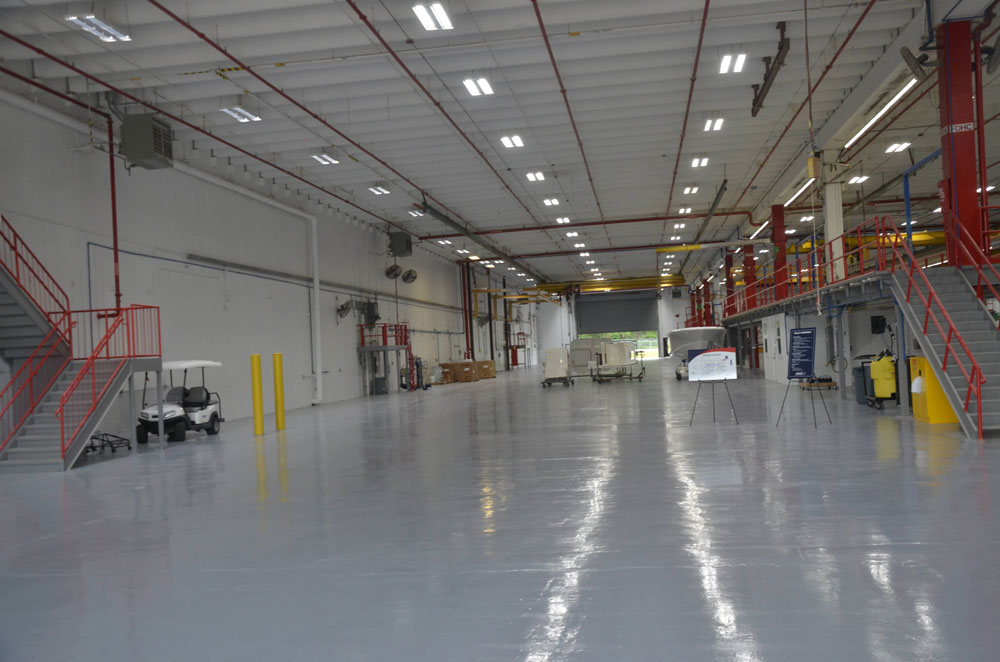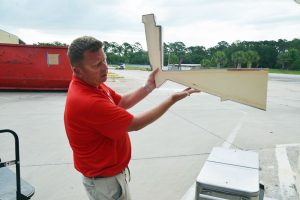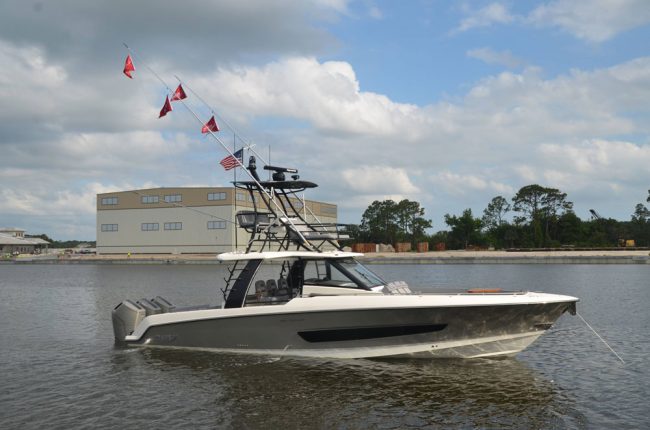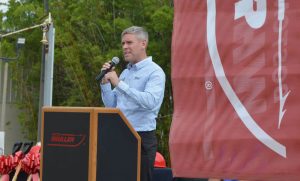
Note: See a full list of jobs available at Boston Whaler here.
What was once the 64-acre Sea Ray plant formally reopened today as Boston Whaler a little less than three years after Brunswick Corp. the parent of both companies, had shut down Flagler County’s largest manufacturing operation. It had 440 jobs at the time. Brunswick and Boston Whaler executives today project the plant will ramp up over the next 12 to 24 months back to 400 jobs, and likely more beyond that: boat-buying is brisk and demand for Boston Whaler is back-ordered well into 2023, the executives say, ensuring the stability of the plant for years to come.
“It’s a really exciting event I think for the Flagler County facility, for Boston Whaler, for Brunswick and for the whole of the community here, I know this means a lot to everybody,” David Foulkes, Brunswick’s chief executive officer, said after just flying in.
“This resurgence in boating is not just a US phenomenon. It is a global phenomena, and we are struggling to catch up,” Foulkes continued. Inventories, he said, are 40 to 50 percent lower than they were pre-pandemic. “That means we have to produce a lot more boats, this year and next year and the year after that, and the year after that, to catch up. If you think about it, we’re producing right now just to meet the incredible retail demand. We are not really doing much to refill that tremendous pipeline. So this facility is going to be busy, not just this year and next year, but for many, many years to come, refilling that depleted pipeline.”
Foulkes spoke at a modest ceremony this morning at the plant, with officials from Palm Coast, Flagler County and Flagler Beach scattered in an audience of around 80 people, including plant staff and executives. The ceremony included a groundbreaking to symbolize the improvements that have been taking place on campus and construction of additional buildings ahead.
On display in the water was one of Boston Whaler’s signature boats, a 42-foot Outrage model (cost: about $1.4 million), along with a Montauk. The Sea Ray plant produced boats aimed largely for recreation. Boston Whaler boats appeal to that market as well, but at its core, the boats are deep-sea saltwater fishing boats, with crossover comforts for pleasure boating. “It’s rugged, the construction, it’s a bit heavier, so it can can really plow through waves,” says Nick Stickler, president of Boston Whaler. “You can go 50 miles offshore, not worried about anything. If you look at the hinges when you get on one of our boats, it almost looks over-engineered because of the environment it’s in bouncing off those waves and in the middle of the ocean.”

Thomas Laraway, the director of operations at the Boston Whaler plant, and John Silva, the project manager, describe how the boats manufactured there have a unique, foam-filled hull that adds to the boat’s stability and safety, making it nearly unsinkable. “So that’s different than the majority of boats,” Laraway said. “It obviously creates a safety for your family. I know I go offshore fishing a lot and when I’m in a Whaler it feels pretty good to know, I’m not going to sink. I mean, no matter what, I’m not going to sink.” The foam process right now is carried out in Edgewater.”All boats have foam on them for Boston Whaler foam is structural,” Silva said. “That’s what makes our construction unique is this a structural foam.”
Exact production rates haven’t been set yet, but a 17-foot Montauk can be manufactured in a matter of days, while a 42-foot Outrage can take up to three months. Both 23-foot Outrage and 17-foot Montauk models will begin to fill assembly lines Monday. The largest Outrage model begins production locally in July.

Boston Whaler has long operated a plant in Edgewater, a 550,000-square feet facility that expanded by 60 acres four years ago and employs 1,300 people. The Flagler-Palm Coast plant began operations in late winter. “We’ve been able to bring in about 15 to 20 people a week fairly steadily for most of the year,” Stickler said. “So it’s good, but it’s not what we need. We need about 100 people up here, between now and later in the year. And we’re still about 100 people short down at our Edgewater campus.” The difficulty hasn’t been in finding people willing to work, he said, but in finding them as fast as the company wanted to find them.
Starting with no skills, no experience and right out of high school, a plant worker will earn about $15 an hour, going up “well into the 20s,” Stickler said. “In fact we’re setting up a finishing school here, which is one of our most skilled trades we need, it takes about nine months for someone to become a good finisher, which is making the fiberglass look nice on the outside. So someone with zero training experience can come in, and if they want to learn We’ll train them.”
Stickler cautions that boating remains a cyclical industry, and that won’t change. But what Boston Whaler is changing at the plant is bringing in more “vertical integration,” such as upholstery work and other component parts of the manufacturing process that previously were done by other suppliers. “Even if we have to bring down boat production, we can produce all of our own parts and make sure we keep the factory running, even if it is a bit of a reduced rate,” he said. On the other hand, if demand ramps up enough, the Flagler-Palm Coast plant could “consume 600 people-plus.”

For nearby Flagler Beach residents and members of the Flagler Beach City Commission, a recurring complaint when Sea Ray operated was styrene, the essential chemical used in the lamination process that produced a distinct odor residents at times complained about. Stickler sought to reassure neighbors that it may be less of an issue with Boston Whaler. “The most important thing when it comes to that is, we’re going to install an interlock system in our lamination building, which is where the styrene is used,” Stickler said. “What that interlock system does is, if anyone opens any of the doors, it shuts off all the equipment. That’s one of the biggest places that styrene was escaping when they open up the doors. So I’m not going to say it’s going to totally eliminate it. But, he said, “we understand it’s been an issue in the past, and we think we can can make it far better than it was before.”When Palm Coast government and Brunswick jointly announced the reopening of the plant in January, the city was bullish on Brunswick’s plans to annex into Palm Coast. Those plans seemed to have cooled considerably. Foulkes at one point in his speech joked that he’d been told not to say “Palm Coast” after he’d filled his notes with references to the city, and Stickler said the plan is “just sitting to the side now, we haven’t really, really progressed talking about that. We want to get the facility up and running, get into things and then see what makes sense for us. Our finance teams were well connected with the communities. And we’ve been working through the details of when and how that makes sense.”
“We haven’t set a timeframe for annexation,” Jason DeLorenzo, the city’s development director, who was among the guests at the groundbreaking, said. Nevertheless, the only elected official who sat alongside Boston Whaler executives today during the speeches was Nick Klufas, the Palm Coast City Council member, there to represent the city since Acting Mayor Eddie Branquinho is out of the country and Milissa Holland, the former mayor–who had touted the Boston Whaler coup in January–had resigned earlier this week.
Jay Gardner, the Flagler County property appraiser, was at this morning’s ceremony both as a public official and a neighbor: he shares a property line with the Boston Whaler plant. “When Sea Ray closed Lisa and I were sad,” Gardner said, referring to his wife, Lisa Gardner. “We like them. They were great neighbors. We don’t have any problems with noise or smell. Granted, it’s fiberglass, and that styrene, if you pout a drop in a cup and put it in your house you’ll smell it everywhere in your house, it does have an odor. But we hardly ever smelled anything. Almost never. Literally, you know, a few times a year, I might notice a little bit, and noise wise they were always quiet.”

Gardner said the property has not experienced dramatic changes in value. The year it closed as Sea Ray, the property’s taxable value was at $5 million, generating $75,000 in property taxes to the county, the school board and other agencies. In 2020 the value of the property had vaulted to $5.9 million, generating $87,000. If the facility were to be annexed into Palm Coast, the city’s property taxes would be levied in addition to that. The 2020 portion of Palm Coast taxes would have added $27,800.Flagler Beach City Commissioner Rick Belhumeur wishes Flagler Beach had started annexation proceedings with the company. “I never realized they were looking to annex, and I can understand why they didn’t come to us after all the opposition in the past,” he said, the city residents’ complaints about odors. “Unfortunate but time goes forward and I wish them the best.” He summed up the plant reopening in one word: jobs.
“I see it as a positive and I know some people are against it for whatever various reasons but it’s economic development,” fellow-Commissioner Ken Bryan said, “and its progress. So I think it’s going to be a lot to the city.”





























Peaches McGee says
The citizens of Flagler Beach will do anything in their power to stop this plant from remaining open just like Sea-Ray.
Mark my words, there will be at least 2 lawsuits within the first 6 months of opening.
Erobot says
Sorry, Peaches. It’s not the citizens, it’s the leadership who live on adjoining road.
Wyatt Johnson III says
People like you are driving great American manufacturing offshore. As if your community has any other economic value beyond low paying service jobs.
Mythoughts says
Money talks no one walks, so when Boston Whaler pays off politicians any complaints from Flagler Beach residences will go down the drain, just wait and see.
Steve says
On the bright side there will be more better paying Jobs.
Now hiring says
My neighbor worked at sea ray and sold his house and left over a year ago. He wouldn’t be able to buy a house here again because it has become quite expensive to do so. I don’t believe the workforce they once had still exists to man a big plant like this. And I doubt one can be created.
Concerned Citizen says
Didn’t we try this already with Sea Ray?